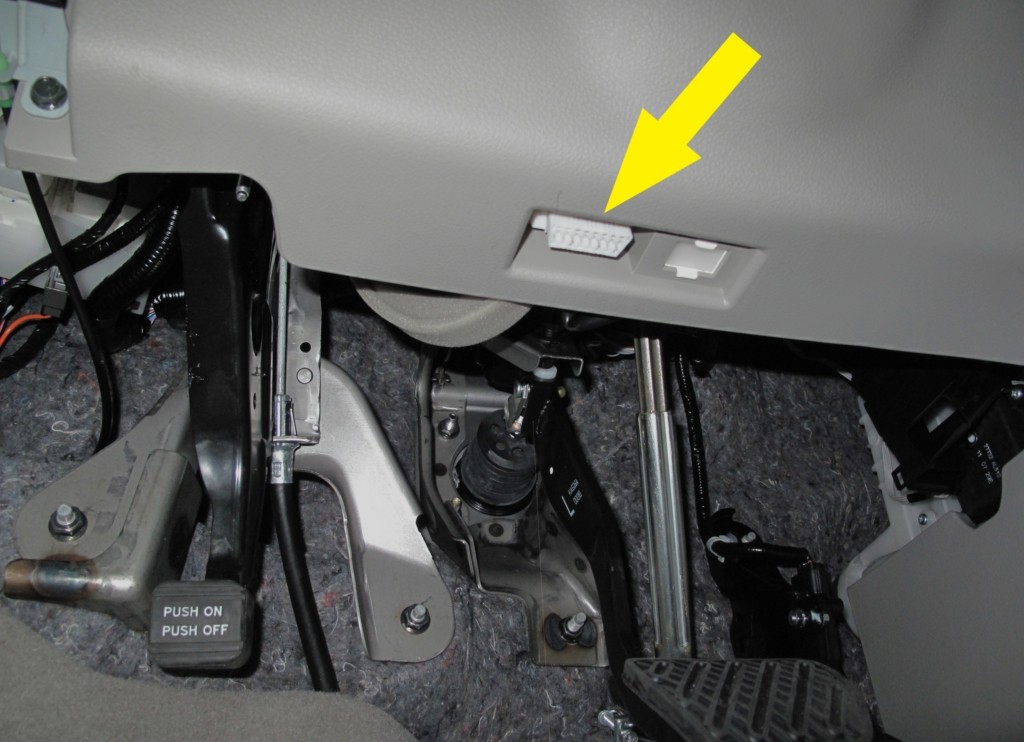The On-Board Diagnostics II (OBD2) port in your 2007 Nissan Quest is a crucial interface for accessing your vehicle’s computer system. Whether you’re a seasoned DIYer or a car owner looking to understand your vehicle better, knowing the location of this port is the first step towards diagnosing issues, monitoring performance, and ensuring your minivan runs smoothly. This guide will pinpoint the OBD2 port location on your 2007 Nissan Quest and explain why it’s so important.
For Nissan Quest owners, especially those with the 2007 model, locating the OBD2 port is usually a straightforward task. You won’t need to spend hours searching or consult complicated diagrams. The OBD2 port is strategically placed for easy access, typically within the driver’s cabin area.
Finding the OBD2 Port in Your 2007 Nissan Quest
In the 2007 Nissan Quest, the OBD2 port is located on the driver’s side, beneath the dashboard. Here’s a step-by-step guide to help you find it quickly:
- Get into the driver’s seat: This will give you the best vantage point for your search.
- Look under the dashboard: Position yourself so you can easily see the area underneath the steering wheel column.
- Check the lower edge of the dash: The OBD2 port is typically found along the bottom edge of the dashboard panel, often near the steering column or slightly to the right.
- Look for a trapezoid-shaped connector: The OBD2 port is a standardized 16-pin connector, easily recognizable by its unique trapezoidal shape. It’s usually black, but can sometimes be other colors.
- Use a flashlight if needed: In some cases, the port might be tucked slightly out of immediate sight. A flashlight can help illuminate the area and make the port more visible.
 OBD2 port location in a Nissan Quest, bottom edge of driver's side dash, under the steering wheel
OBD2 port location in a Nissan Quest, bottom edge of driver's side dash, under the steering wheel
Once you locate this connector, you’ve found the OBD2 port in your 2007 Nissan Quest. It’s designed for easy access, so you shouldn’t need any tools or require any contortionist maneuvers to reach it.
Why is the OBD2 Port Important?
The OBD2 port is more than just a connector; it’s a gateway to your vehicle’s internal computer system. Here’s why it’s a vital component:
- Vehicle Diagnostics: The primary function of the OBD2 port is to allow mechanics and car owners to diagnose vehicle problems. When your check engine light illuminates, it signifies that the vehicle’s computer has detected an issue. An OBD2 scanner, when plugged into this port, can read diagnostic trouble codes (DTCs) that pinpoint the source of the problem.
- Emissions Testing: OBD2 systems monitor your vehicle’s emissions control systems to ensure they are functioning correctly and meeting environmental standards. In many regions, emissions testing is conducted via the OBD2 port.
- Performance Monitoring: Beyond diagnostics, the OBD2 port can be used to monitor various aspects of your vehicle’s performance in real-time. With the right scan tool or app, you can track parameters like engine temperature, RPM, speed, fuel efficiency, and much more. This is useful for both performance enthusiasts and everyday drivers who want to keep a close eye on their vehicle’s health.
- Accessing Advanced Features: Some aftermarket devices and software utilize the OBD2 port to enable advanced features, such as performance tuning, data logging, and customized vehicle settings.
Using an OBD2 Scanner with Your 2007 Nissan Quest
Once you’ve located the OBD2 port, using it is simple. Here’s a general guide on how to use an OBD2 scanner:
- Purchase an OBD2 Scanner: OBD2 scanners are readily available online and in auto parts stores. They range from basic code readers to advanced professional-grade scan tools. Ensure the scanner you choose is compatible with OBD2 protocols and your smartphone if it’s a Bluetooth or Wi-Fi based scanner.
- Plug in the Scanner: With your Nissan Quest turned off, locate the OBD2 port and firmly plug in your scanner.
- Turn on the Ignition: Turn your key to the “ON” position (or start the engine, depending on the scanner’s instructions).
- Follow Scanner Instructions: Each scanner varies slightly, so follow the manufacturer’s instructions to power it up and initiate a vehicle scan.
- Read Diagnostic Trouble Codes (DTCs): If there are any issues, the scanner will display DTCs. Record these codes, as they are your starting point for diagnosing problems.
- Clear Codes (Optional but with Caution): Most scanners allow you to clear DTCs after addressing the issue. However, only do this if you understand the problem and have resolved it. Clearing codes without fixing the underlying issue will only cause the check engine light to reappear.
Troubleshooting OBD2 Connection Issues
In rare cases, you might encounter issues connecting your OBD2 scanner. Here are a few common troubleshooting steps:
- Ensure Scanner Compatibility: Double-check that your scanner is indeed OBD2 compliant and compatible with the 2007 Nissan Quest.
- Check the Connection: Make sure the scanner is firmly plugged into the OBD2 port. A loose connection can prevent proper communication.
- Verify Vehicle Ignition: Ensure your vehicle’s ignition is turned to the “ON” position as required by your scanner. Some scanners may need the engine running.
- Scanner Malfunction: If possible, try a different OBD2 scanner to rule out a malfunction with your initial device.
- Vehicle-Side Issues (Rare): In very rare cases, there might be an issue with the vehicle’s OBD2 port or wiring. If you suspect this, it’s best to consult a professional mechanic.
Conclusion
Locating the OBD2 port in your 2007 Nissan Quest is a simple task that unlocks a wealth of diagnostic and monitoring capabilities for your vehicle. By understanding where this port is and how to use it with an OBD2 scanner, you can take a more proactive approach to vehicle maintenance, diagnose problems effectively, and ensure your Nissan Quest continues to provide reliable service for years to come. Keep this guide handy, and you’ll always be ready to tap into your vehicle’s diagnostic data whenever needed.

